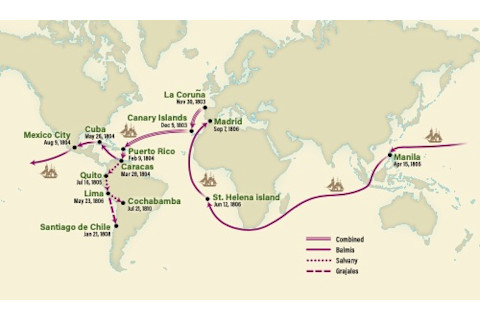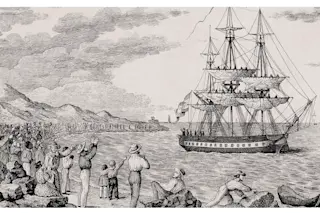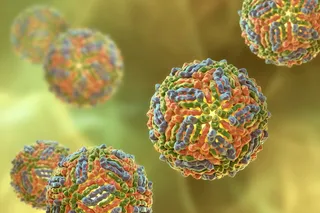This story was originally published in our September/October 2022 issue as "The First Global Vaccination Campaign." Click here to subscribe to read more stories like this one.
On Nov. 30, 1803, military physician Francisco Xavier de Balmis set off from the port of La Coruña in northwest Spain on what would become a three-year mission. On board with him were 22 orphan boys. Their goal: to complete the first global immunization campaign.
The world was riddled with smallpox, which killed one-third of all infected. Though Edward Jenner had discovered in 1797 that pus from a cow’s cowpox blisters could be used as a vaccine, the majority of the world had no access to the inoculation. Cowpox was such a local disease, mostly found in England and occasionally France or Italy, that it was unclear how anyone could scale vaccination to more people.
Scientists had yet to discover germ theory, so no one knew what a virus was. They did know that they needed to spread cowpox in order to keep the vaccine alive, but prior methods, like putting active disease material (in other words, pus) from an infected person onto cloth or in a vial and rubbing that into the wound of a recipient, didn’t work over long distances. Taking a whole cow to disease hotspots was equally impractical. Today, such viral material is kept alive by refrigeration — technology and know-how scientists just didn’t have back then.
Eventually, Jenner came to the realization that he could remove the cow from the vaccination equation. He discovered that by taking the pus from a vaccinated person’s cowpox blisters and putting it into the arms of others, he could create a “warm chain”: arm-to-arm vaccination.
As Jenner was making and publicizing his discoveries, King Charles IV of Spain was watching in horror as family members and millions of people in his colonies were felled by smallpox. He conceived of a grand mission, the Royal Philanthropic Expedition of the Vaccine, which would take the vaccine to the Americas, save his people, and make the Spanish Empire the first with a robust plan against the pox. But the king needed someone to helm the mission, someone who could turn those ideals into reality — a tall order.
Balmis was the perfect candidate. The then-50-year-old was a military physician who had spent years abroad studying alternative medicines in Mexico and Central America. He also had just translated the book The Historical and Practical Treatise on the Vaccine by J.L. Moreau de la Sarthe, the most comprehensive study of vaccines at the time, into Spanish from the original French. Balmis heeded the King’s call, and when he learned of Jenner’s arm-to-arm method, he knew it was exactly what he needed. He would take the vaccination to the Americas through human bodies.
Children Were Key
Balmis couldn’t take adults. Smallpox was so incredibly infectious that any adult alive probably had already lived through the disease, and anyone with existing immunity would fail to develop the blisters needed to harvest more pus and propagate the vaccine.
Children were the only subpopulation that could keep the vaccine alive, so Balmis recruited 22 orphan boys, aged 3 to 10 years old. King Charles announced that the crown would take care of all these boys as compensation for their bravery, taking on all expenses related to the boys’ wellbeing and ensuring their schooling and financing until they were old enough to support themselves.
In addition to the boys and the regular sailing crew, Balmis had three assistants, two physicians, three nurses, a secretary, and Isabel Zendal Gómez, the director of the La Coruña orphanage who served as the boys’ primary caretaker. The expedition would sail to all of Spain’s colonies, but the plan went beyond simply inoculating the colonists. Balmis and his staff would also distribute copies of his translated book to help educate physicians on the updated science, train doctors to administer the vaccine, and assist in the formation of central vaccination boards at every location.
Balmis paired off the boys, vaccinating the first two lads right before the ship disembarked. Their ship, the Maria Pita, then took to the seas. Nine days or so after vaccination, the boys developed the typical cowpox lesions on their bodies. Balmis and his medical crew took the pus from those two children and used it to vaccinate the next two boys, cycling through this routine with each successive pair to keep the vaccine alive. With such a high-stakes mission at hand, Balmis had to vaccinate two boys at a time as insurance that, should something happen to one child, the vaccine would not be lost.
The Maria Pita made its way to Puerto Rico, stopping en route at the Canary Islands to vaccinate the Spanish colonies there, and landed on Feb. 9, 1804. It was anticlimactic. By some luck, others had managed to sail active disease material, in the form of encrusted lymph fluid, from England to other nearby islands and then on to Puerto Rico. Most of the population was already vaccinated.
So the expedition set off for its next stop, Venezuela, docking on March 20 in the nick of time — only one of the vaccinated boys still had active pus blisters from which to draw. Balmis rushed out as soon as they landed, immediately vaccinating 28 local children to keep the reservoir of vaccine alive.
After administering the vaccine to a reported 12,000 individuals in Venezuela, Balmis was torn. There was so much more land to cover, both further down in South America, in Mexico to the north, and beyond. For expediency, he decided it best to split the voyage into two: His deputy, José Salvany, would travel down to Colombia, Peru, Ecuador, Boliva, and the rest of Spanish South America. Balmis would head to Cuba, Mexico, and the Spanish colonies in Asia. And so the Balmis Expedition branched, and the two leaders embarked on their separate legs with new groups of boys – rounded up with the cooperation of local officials, the Catholic Church and family volunteers – as carriers for the vaccine.

Balmis circled the globe and deputies Jose Salvany and Manuel Grajales traveled through South America, each inoculating the public and educating local physicians along the way. (Credit: Kellie Jaeger for Discover)
Kellie Jaeger for Discover
Balmis spent the following months in Cuba, and then different regions of Mexico. Some pockets of the population were already vaccinated, some communities were skeptical of the foreign vaccine, and some regional leaders butted heads with the strong-willed Balmis — this was just seven years before the start of the Mexican War of Independence in 1810, and the people in the New Spain territories were reluctant to cooperate with the Spanish crown.
At times it looked like the cowpox vaccine would run dry and the expedition would be cut short. But despite close calls due to stormy weather and travel delays, Balmis persevered with the vaccine intact. At every stop he made sure always to instruct new physicians on how to schedule vaccinations to best keep the cowpox alive. He also helped local authorities set up vaccination institutions to oversee and track the administered doses. Versions of some of those vaccine boards still exist today. While records are incomplete, experts today believe the team managed to vaccinate 100,000 to 150,000 people in North and South America.
Balmis then headed to the Spanish colonies in the Philippines in February 1805. After repeating his efforts there, he was ready to go home; he sailed west with a small crew and three new boys, stopping to vaccinate Macau (a Portuguese colony) and Canton, and was finally Europe-bound by 1806.
Pioneers of Protection
After a brief stop at St. Helena, the worn physician reached his homeland in September. Back in Spain almost three years after he left, Balmis received a warm welcome from King Charles, and mass praise for his efforts.
“Balmis conceived of vaccination as public health, and there are people who refer to the Balmis Expedition as the first global public health vaccination campaign,” says José Esparza, a Venezuelan doctor and virologist at the University of Maryland who has researched the expedition extensively. “At that time, vaccination was seen mostly as a means to prevent individual diseases in people, not as a public health enterprise.”

A sculptural monument to the Balmis Expedition stands in the port of La Coruna. (Credit: Caronium, Wikimedia Commons)
Caronium, Wikimedia Commons
The vaccine had often preceded Balmis in different communities, yet none of the places he visited had established mass vaccination initiatives. There had been isolated initiatives, but not an organized vaccination campaign. “Maybe the lesson here is that we must pursue both goals of vaccination,” says Esparza. “Protection of individuals, but also the protection of societies.”
Of course, the Balmis Expedition was not done purely out of philanthropy — losing masses of people to smallpox was an economic detriment to the Spanish crown, and by vaccinating non-Spanish territories, Balmis hoped to better international relations. But the vaccine was always free. Often, Balmis even paid families to vaccinate their children.
At the time, the Spanish Empire was the largest in the world. They took the vaccine to territories across three continents and two oceans — an amazing example of what we can accomplish when higher-income countries mobilize to help lower-income countries, says Enrique Soto, a geriatric oncologist at the Instituto Nacional de Ciencias Médicas y Nutrición Salvador Zubirán in Mexico City, who has written about the Balmis Expedition.
The Royal Philanthropic Expedition of the Vaccine is a storied journey that tells a lot about the history of vaccination campaigns, Soto says, but it also reveals all the lessons we have not learned. Vaccine hesitancy, for example, is not new, which is why clear and proactive science communication is paramount. “If we have the vaccines and people don’t take them, then vaccines are useless.”
Soto adds that there are a few parallels between the Balmis Expedition and COVAX, the United Nations’ effort to produce and disseminate COVID-19 tests, treatments, and vaccines globally and equitably. It’s bewildering, he says, that our technology has advanced so much since the 1800s, yet international collaboration and philanthropy is still so difficult to pull off.
To this day, smallpox is the only infectious disease in humans that has ever been eradicated — a feat managed only through the initiative and action taken by a few pioneers who understood that properly tackling an infectious disease means protecting everyone. The story of the Balmis Expedition is little known, says Soto. But, it should be talked about more, Esparza says, “because the people involved are heroes, and those nurses were the first global public health nurses in history. It is such an amazing story.”














